GARDEN
10 Stunning Plants to Give a Vibrant Color Display for Fall
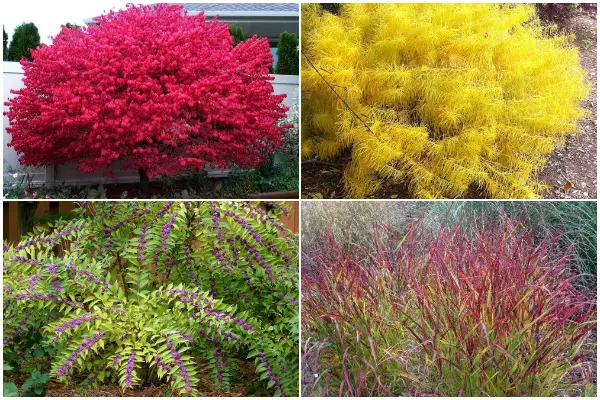
If you love enjoying the fall garden with a truly impressive showing of transition, the best foliage plants will explode with color and put out a dazzling display from late summer into early winter.
1. Quaking Aspen
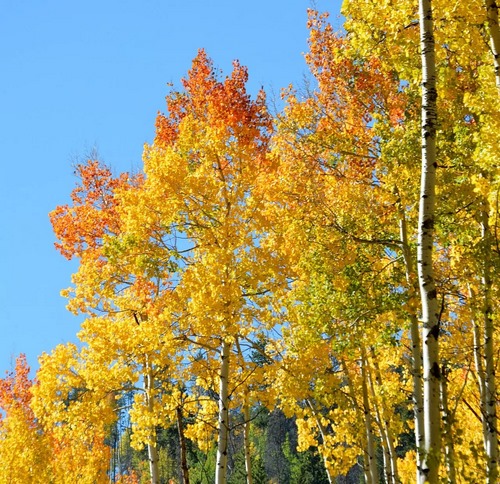
A tall and slender tree, quaking aspen (Populus tremuloides) is so named due its habit of shivering and trembling in the breeze.
Growing up to 80 feet at maturity, quaking aspen is notable for its smooth silvery trunk topped with a canopy of rounded, slightly serrate leaves that start out lime green and transition to golden yellow in autumn.
Hardy in zones 1 through 7, quaking aspen’s native range spans Alaska all the way down to the mountains of Central Mexico.
It’s a fast grower too, increasing its height by 24 inches each year. Plant quaking aspen in full or part sun in a spot with acidic, loamy soil.
2. Sugar Maple
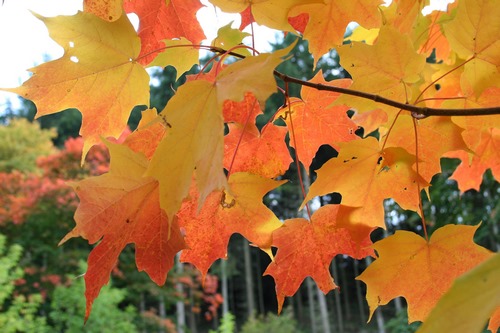
Sugar maple (Acer saccharum) is a shade tree renowned for its spectacular foliage colors.
Starting out as emerald green in spring and summer, sugar maple leaves slowly transition to lime green, bright yellow, vibrant orange, and fire engine red, finishing its cycle in a deep burgundy.
In addition to its beauty, sugar maple is an excellent source of maple syrup.
When the diameter of the tree trunk is larger than 10 inches, it can be tapped for your own source of the sweet stuff.
Native to central and eastern parts of North America, sugar maple is hardy in USDA zones 3 to 8.
Although sugar maple prefers full sun, it can adapt to partial shade. In the forests, sugar maple can reach heights of up to 120 feet, but in residential settings it will usually only grow to 70 feet over its 200 year lifespan.
3. Switch Grass
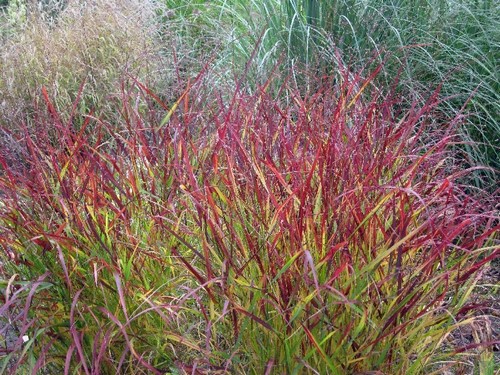
Switch grass (Panicum virgatum ‘Shenandoah’) is a perennial, warm season grass found in much of North America east of the Rocky Mountains.
An important plant in the tallgrass prairie ecosystem, switch grass is also quite ornamental, adding both texture and color to the garden.
Growing in 3 foot high clumps, its stiff leaves stay upright throughout the season.
The foliage begins as bluish green with red highlights in summer, turning shades of purple, burgundy, and wine in fall. When in bloom, it bears reddish pink floral panicles that appear to hover over the leaves like a cloud.
Cultivate switch grass in full sun to part shade, in zones 5 to 9.
4. Burning Bush
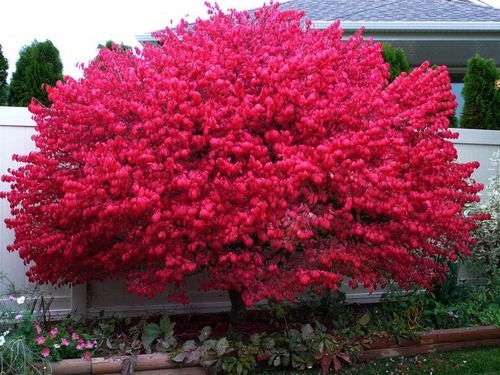
When you need a shock of red in your autumn landscape, burning bush (Euonymus atropurpureus) will certainly fit the bill.
Also known as eastern wahoo, burning bush is part of the bittersweet family and is indigenous to the Midwest, found as far south as Florida and Texas.
An upright shrub that can reach a height of 20 feet and 25 feet wide, it produces a clump of branches at its base that extend outwards to form an irregular crown of elliptical leaves.
Green in spring and summer, burning bush turns a dramatic scarlet red in fall with dangling fruit clusters – poisonous to us but much beloved by wild birds.
Requiring full sun to part shade, burning bush is hardy in zones 3 through 7.
5. Virginia Creeper
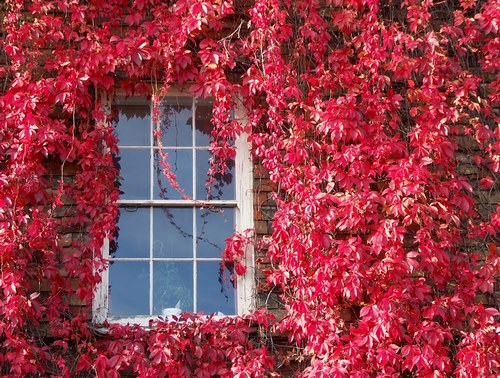
When you love the look of an ivy-covered façade, Virginia creeper (Parthenocissus quinquefolia) is an excellent choice.
Virginia creeper is a fast and vigorous woody vine, with palmately compound leaves composed of 5 serrate leaflets, each about six inches long.
In spring leaves are lime colored and slowly transition to hunter green in summer, finishing in autumn with dazzling shades of scarlet and magenta.
It also bears tiny blue-black berries, another valuable food source for birds over winter.
Although Virginia creeper is really easy going – it will grow in practically any sunlight condition and soil type – it should be planted in a spot where it has room to grow.
Virginia creeper helps keeps buildings cooler in summer by providing a bit of shade to the wall surface.
It attaches to brickwork and other vertical surfaces with little sucker disks, so it won’t harm your masonry like other vines that cling with penetrating roots.
Still, you’ll want to trim it back each year and keep it far away from wiring, shutters, and gutters.
This clinger is native to central and eastern North America, and is hardy in zones 3 to 9.
6. American Smoke Tree

American smoke tree (Cotinus obovatus) is so named for its floral clusters that, when spent in midsummer, turn into fluffy, billowy hairs that appear as puffs of pinkish smoke over its crown.
Often considered to be one of the best native trees for brilliant fall color, American smoke tree transitions from blue-green leaves to an array of autumnal hues, including yellow, red, orange, and purple.
Reaching a size of 20 to 30 feet tall and wide, American smoke tree requires full sun and medium moisture.
It adapts well to many soil types but prefers well-draining, somewhat infertile loamy soil.
Though American smoke tree’s native range is the southern United States, it is hardy in cooler climes from zones 4 to 8.
7. Blue Star Amsonia
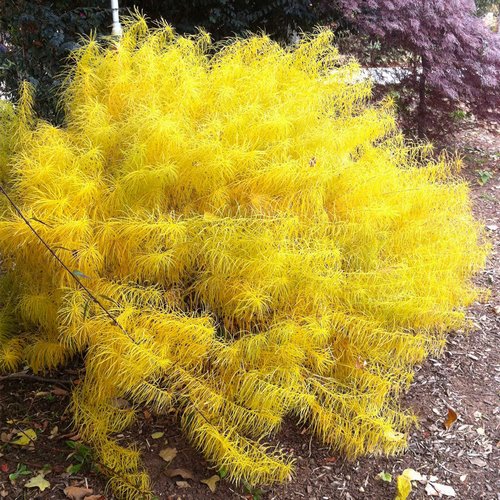
Found growing in the wilds of the Ouachita Mountains in Arkansas, blue star amsonia (Amsonia hubrichtii) is an upright, mounding plant that produces clusters of ghostly blue star-shaped flowers in spring.
Its airy and soft needle-like foliage is bright green throughout the summer, but turns a flashy golden yellow to burnt orange in autumn.
The feathery and bushy growth habit, reaching 3 feet high, makes a wonderful contrast when planted along walkways or as a backdrop for fall bloomers like autumn crocus and mums.
Blue star amsonia has a very easygoing nature, simply plant it in full sun in zones 5 to 8.
8. Virginia Creeper

When you love the look of an ivy-covered façade, Virginia creeper (Parthenocissus quinquefolia) is an excellent choice.
Virginia creeper is a fast and vigorous woody vine, with palmately compound leaves composed of 5 serrate leaflets, each about six inches long.
In spring leaves are lime colored and slowly transition to hunter green in summer, finishing in autumn with dazzling shades of scarlet and magenta.
It also bears tiny blue-black berries, another valuable food source for birds over winter.
Although Virginia creeper is really easy going – it will grow in practically any sunlight condition and soil type – it should be planted in a spot where it has room to grow.
Virginia creeper helps keeps buildings cooler in summer by providing a bit of shade to the wall surface.
It attaches to brickwork and other vertical surfaces with little sucker disks, so it won’t harm your masonry like other vines that cling with penetrating roots.
Still, you’ll want to trim it back each year and keep it far away from wiring, shutters, and gutters.
This clinger is native to central and eastern North America, and is hardy in zones 3 to 9.
9. Staghorn Sumac
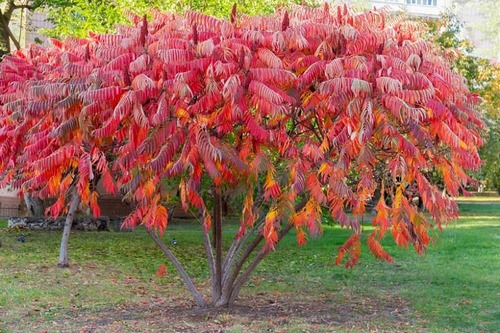
Sumac (Rhus spp.) is a type of small tree or shrub found in temperate regions across the globe.
In North America, there are several species of native sumac that provide seasonal interest throughout the year.
Notable for its bright, eye-catching foliage in autumn, sumac also produce large floral spikes in spring that mature into colorful clusters of drupes that persist into winter.
These berry like fruits provide a good source of food for local wildlife too.
Staghorn sumac (R. typhina) has a fern-like appearance, with feathery leaves that are pinnately arranged along the stem.
Named for its forking branches that have a velvety texture, similar to antlers, staghorn sumac’s foliage turns eye catching colors in fall, ranging from bright red to orange to burgundy.
Staghorn sumac is hardy in zones 4 to 8.Other good fall foliage varieties of sumac include fragrant sumac (R. aromatica), smooth sumac (R. glabra), prairie sumac (R. lanceolata), and shining sumac (R. copallinum).
10. Virginia Sweetspire
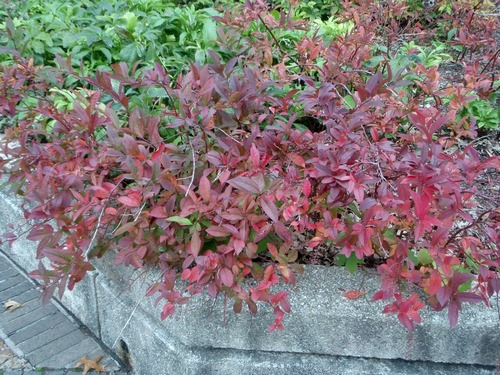
Virginia sweetspire (Itea virginica ‘Henry’s Garnet’) is a flowering shrub native to the southern United States.
Its rounded growth habit, more broad than tall, is composed of numerous arching stems dappled with simple oval leaves.
In May, it explodes in blooms – fragrant, small white flowers in drooping racemes cover the entire plant.
Come autumn, Virginia sweetspire slowly transitions from green to gold, orange, and finally, a rich crimson red. The specific cultivar, ‘Henry’s Garnet’ has the best fall color of the sweetspires.
Grown in zones 5 to 9, Virginia sweetspire prefers full sun but is adaptable to shade.
Plant it in a spot that has good drainage but is naturally wet, near streams or low lying areas.
10. American Beautyberry
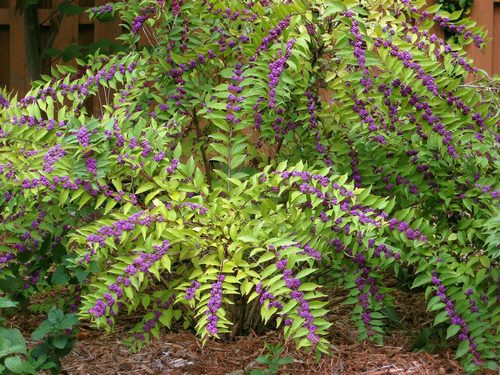
While the fall garden should celebrate the amazing show of colors of the season, be sure to leave room in your garden beds for interesting shapes and textures.
The American beautyberry is one example where its foliage is fairly ordinary, but is cherished for its large clusters of violet drupes that persist through winter.
The berries are edible, but are quite astringent and should only be consumed in small amounts. They can be used to make jellies and wines, or leave them on the branch for foraging animals.
Providing a lovely contrast for your foliage plants, beautyberry grows as a loose shrub, only 3 to 6 feet as tall and wide.
It bears its fruit most profusely in full sun and when several are planted together.
American beautyberry is hardy in zones 6 to 10.
GARDEN
15 Houseplants That Grow Well in Vases with Water
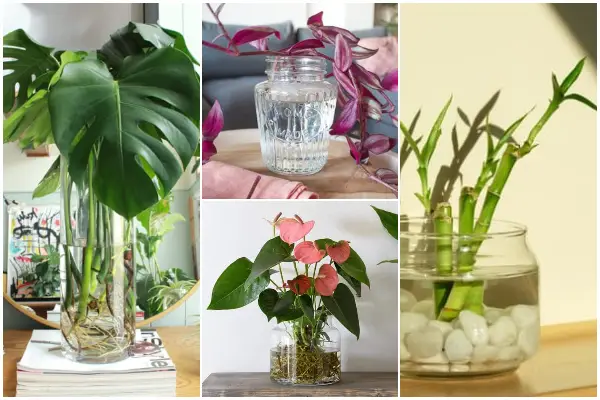
Vases are a fun way to display the beauty of flowers or propagate plants from cuttings. No need for the soil, simply immerse the nodes or the end of the stems in the water, add some decorative gravel, and you are done! They are so easy to make that everyone can create them at home, and especially your hand is always clean.
Instead of decorating flowers, check out the 15 Houseplants That Grow Well in Vases to make the living space more impressive in your own way.
1. Pothos
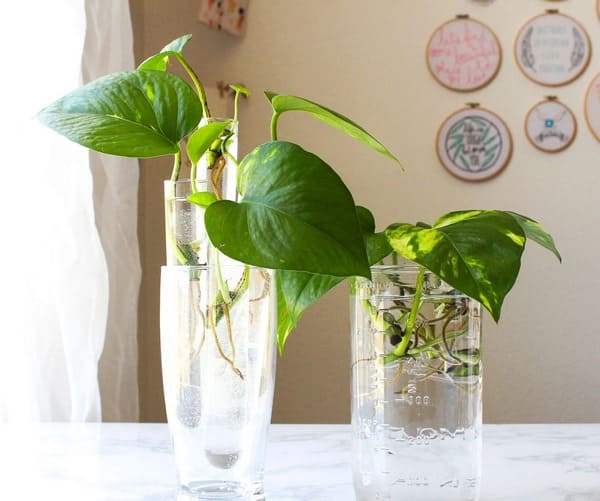 Image source: instructables
Image source: instructables
This Pothos displays heart-shaped green and white leaves making it looks stunning in decorative vases. The houseplant needs a little care and indirect light for happy growth.
2. Spider Plant
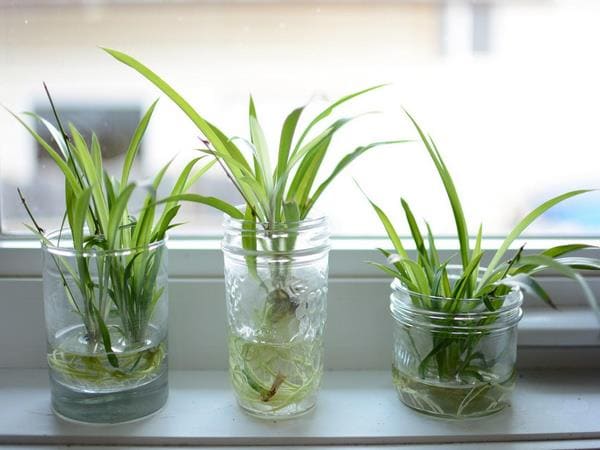 Image source: gardenmanage
Image source: gardenmanage
Spider Plant is one of the most popular houseplants. You can grow in pots in soil or in vases in water. Simply, cut off one of the plantlets, then put it in your vase.
3. Snake Plant
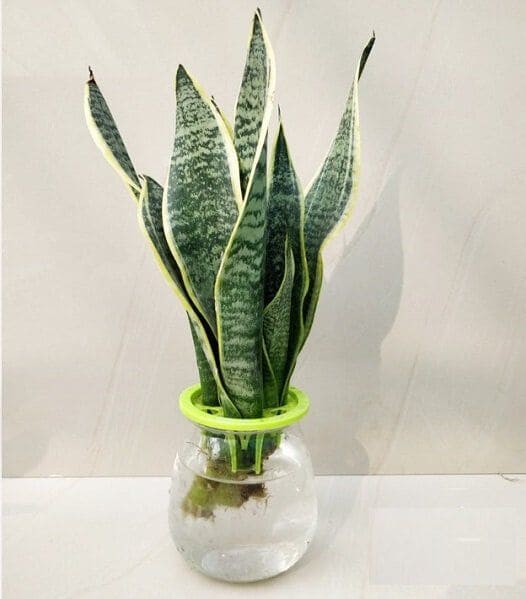 Image source: plantdecors
Image source: plantdecors
Snake Plant looks great in a transparent vase with tall variegated leaves. It is also excellent for purifying harmful toxins from the air.
4. Monstera
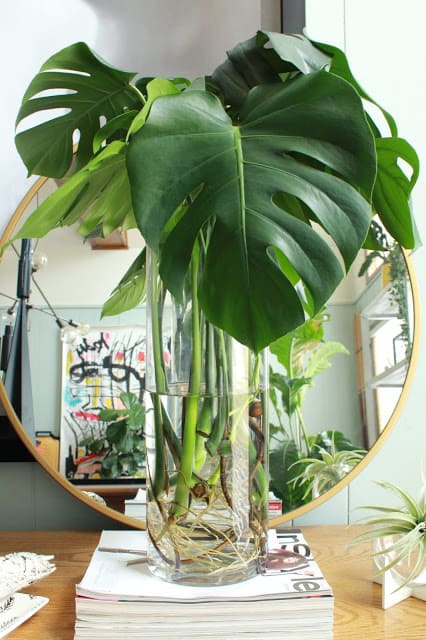 Image source: keephouseplantsalive
Image source: keephouseplantsalive
Monstera offers unique cut leaves looking gorgeous when put in a matching vase. This low-maintenance plant also grows well in the water environment.
5. Purple Heart Plant
 Image source: creativejewishmom
Image source: creativejewishmom
By providing deep purple leaves with delicate and tiny pink flowers, this Purple Heart Plant looks more beautiful in a vase.
6. Watermelon Peperomia
 Image source: kirkdamaso
Image source: kirkdamaso
This Watermelon Peperomia shows off thick and bushy foliage, making it an amazing centerpiece. The best varieties are Columbian and Watermelon Peperomia which you should choose to grow.
7. Geranium
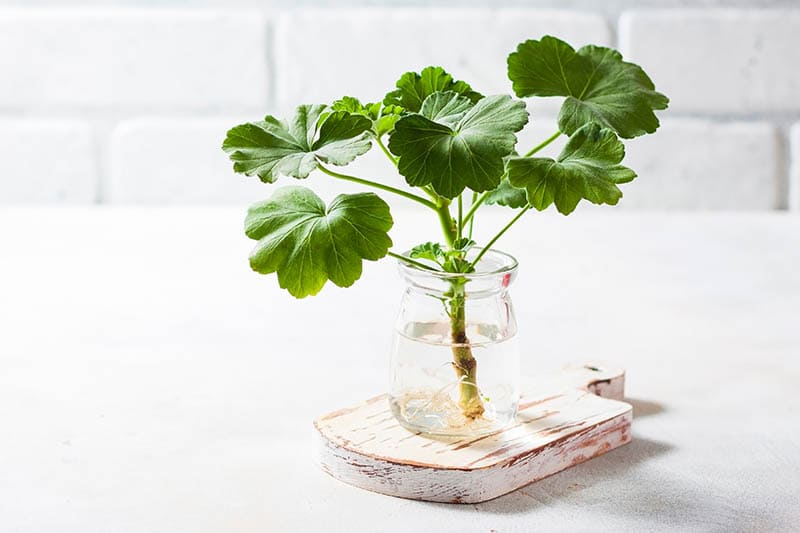 Image source: gardenerspath
Image source: gardenerspath
Geranium is a well-loved houseplant because of its easy-to-take-care properties along with its bright pink flowers. Growing it in a vase with water is a great way to start a plant from cuttings!
8. Alocasia
 Image source: carousell
Image source: carousell
Alocasia bears arrow-shaped leaves that look stunning in glass vases. It is quite easy to propagate and grows happily in indirect light.
9. Chinese Money Plant
 Image source: bonjourtangerine
Image source: bonjourtangerine
Chinese Money Plant is a compact specimen that looks impressive when kept on small tables and windowsills.
10. Wandering Jew
 Image source: lady-bella
Image source: lady-bella
This fast-growing plant brings pretty purple-colored and variegated leaves looking smashing in vases.
11. English Ivy
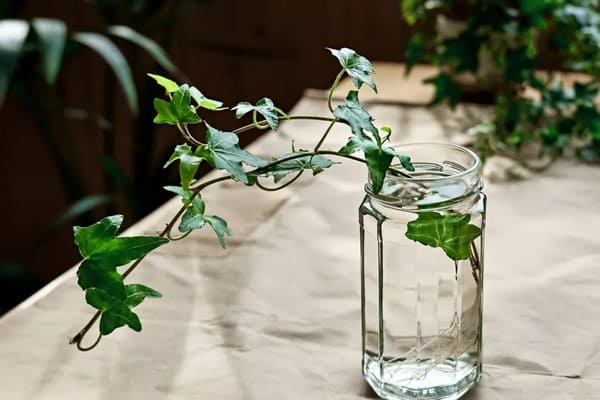 Image source: ruralsprout
Image source: ruralsprout
English Ivy is an evergreen vine with flexible stems dangling down, which makes it look quite charming in a vase.
12. Swiss Cheese Plant
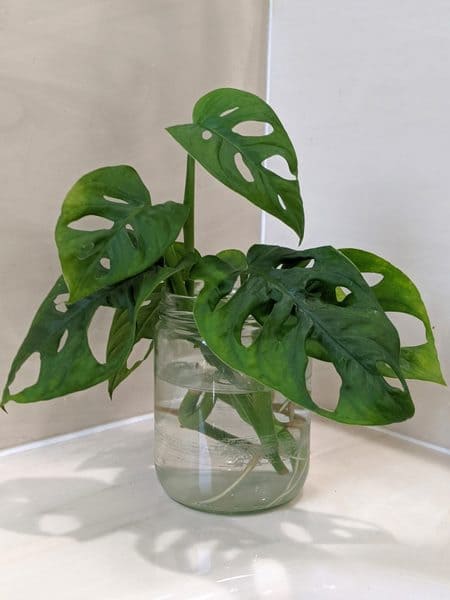 Image source: pottedpixie
Image source: pottedpixie
The leaves of this Plant have natural holes looking like swiss cheese, as the name suggests. This plant also loves climbing so you can place it near a shelf and watch it grow upwards!
13. Peace Lily
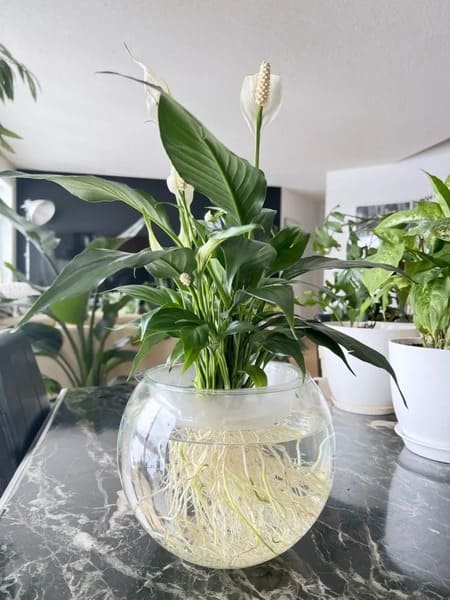 Image source: jaydeemahs
Image source: jaydeemahs
Peace Lily is a popular houseplant that showcases the combination of the white and green leaves looking quite classy. It is also easy to maintain.
14. Anthurium
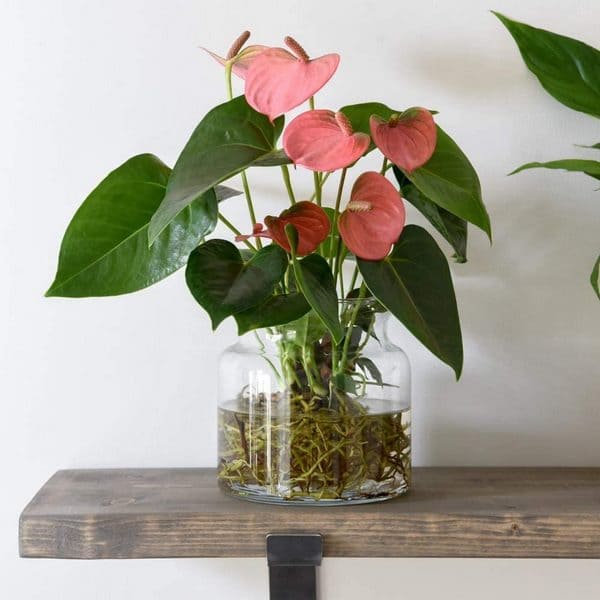 Image source: amazon
Image source: amazon
Anthurium blooms colorful bracts pop against dark green foliage making. It can do well in a transparent vase in the water.
15. Lucky Bamboo
 Image source: modernfarmer
Image source: modernfarmer
Lucky Bamboo is an easy-to-maintain plant that can grow well in any condition. It also is famous for its air-purifying ability you can grow.
GARDEN
15 Different Fern Types to Grow Indoors
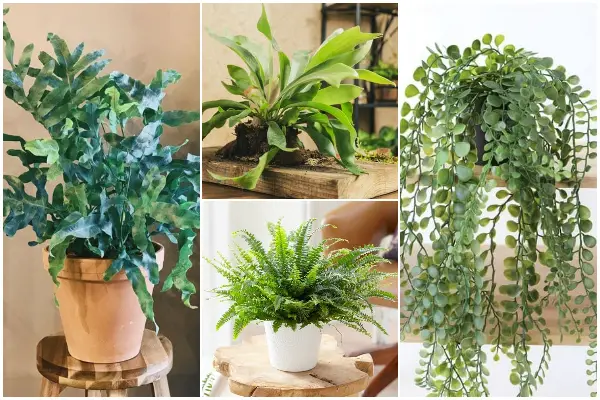
Want to bring tropical beauty to the home, indoor ferns are a lush and rewarding addition to any space. With vibrant, cascading fronds that stand out among other indoor plants, they are the top options for adding plant life and texture to your living space.
Here are the 15 Different Fern Types below that you will love growing. Like other houseplants, they also adapt to indoor conditions with minimal care.
#1 Kangaroo Fern (Microsorum diversifolium)
 Image source: rhsplants
Image source: rhsplants
Kangaroo Fern comes from Western Australia that features odd-shaped, long bright green fronds growing from creeping fuzzy rhizomes. To grow this fern, let’s give it moist soil and place it in a warm location.
#2 Boston Fern (Nephrolepis exaltata)
 Image source: etsy
Image source: etsy
Boston Fern is also called the sword or ladder fern, it has blue-green sword-shaped fronds that stay evergreen with arching gorgeous erect leaflets. This plant grows well in low light and just with minimalistic attention.
#3 Botton Candy Boston Fern (Nephrolepis ‘Cotton Candy’)
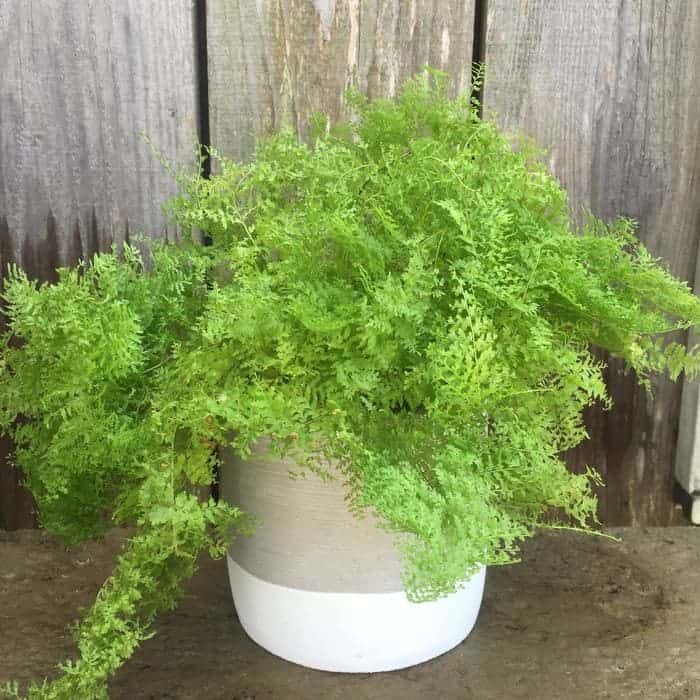 Image source: gatewaygardens
Image source: gatewaygardens
Cotton Candy Boston Fern does well both indoors and outdoors to show off fuzzy, soft, and bright green fronds. It looks great when grown in pots or hanging baskets. For its happy growth, give it in a shady location outdoors and on an Eastern direction window indoors.
#4 Bird’s Nest Fern (Asplenium nidus)
 Image source: springhillnursery
Image source: springhillnursery
Bird’s Nest Fern is an easy-care epiphyte variety as long as it gets enough humidity. In the right condition, it will bring leathery, strap-shaped, shiny, bright apple green fronds patterned in dark brown to black midribs and wavy edges.
#5 Blue Star Fern (Phlebodium aureum)
 Image source: instagram
Image source: instagram
Blue Star Fern is an epiphyte fern that adapts fast to the indoor environment. Its blue-green leaves are sometimes speckled with a silver or gray hue. To plant it indoors, give it well-draining soil, or an equal mix of perlite, pumice, or gravel.
#6 Lemon Button Fern (Nephrolepis cordifolia ‘Lemon Button’)
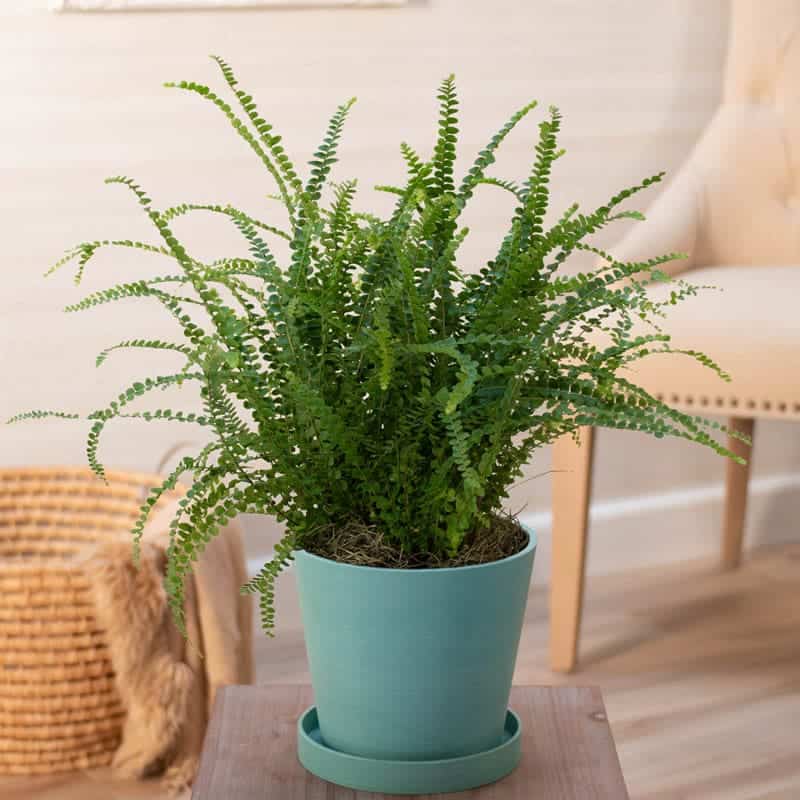 Image source: brecks
Image source: brecks
Lemon Button Fern showcases tiny, golden-green round button-like leaflets. When grown in hanging baskets or in terrariums, its long, arching leaves give a stunning look. For its optimum growth, give it medium to bright light and high humidity.
#7 Squirrel’s Foot Fern (Davallia bullata)
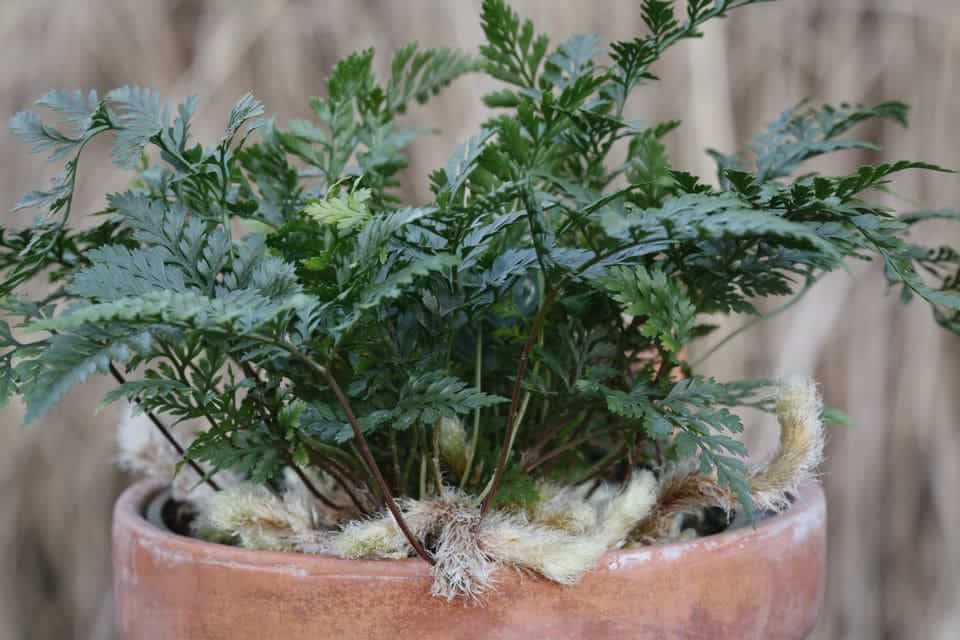 Image source: greencloudsolutions
Image source: greencloudsolutions
In the wild, the plant’s rhizomes of the Squirrel’s Foot Fern wrap around a tree to cling to them, hence the name. Place in indirect light and highly humid conditions, it will grow best to produce lacy and green foliage.
#8 Cretan Brake Fern (Pteris cretica)
 Image source: etsy
Image source: etsy
Native to Europe, Africa, and Asia, this evergreen fern has innate, flat green fronds with attractive variegation and wavy edges. The Cretan Brake Fern favors growing in a humid environment, so you can grow it in hanging baskets and place it in bathrooms or on tabletops.
#9 Maidenhair Fern (Adiantum)
 Image source: englishgardens
Image source: englishgardens
Maidenhair Fern is a popular fern that performs delicate, light, lacy, airy, bright green leaves on slender black stems, making it look great in hanging baskets. This fern variety requires slight moisture and bright indirect sunlight for its happy growth.
#10 Asparagus Fern (Asparagus aethiopicus)
 Image source: jensplantsandflorist
Image source: jensplantsandflorist
Asparagus Fern is one of the best hanging ferns that you can in baskets and macrame holders to enjoy its lacy-green foliage leaves. To grow this fern, give it humid locations and mist regularly, especially in summer.
#11 Japanese Holly Fern (Cyrtomium falcatum)
 Image source: plantify
Image source: plantify
Japanese Holly Fern shows off serrated, sharp-tipped long deep green leathery fronds that look like holly branches. This fern grows well both in partial sun and shade, so it thrives well indoors with minimum maintenance.
Native to New Zealand, the Button Fern is a beautiful, easy-to-grow fern. It displays round and small leaflets or ‘buttons’ on slim stems, hence the name. This fern variety adapts well to average indoor conditions.
#12 Rabbit’s Foot Fern (Humata tyermanii)
 Image source: hearthandvine
Image source: hearthandvine
Rabbit’s Foot Fern loves growing in bright, indirect light. It produces dark green, delicate, fine-textured fronds on fuzzy root-like stems (rhizomes).
#13 Staghorn Fern (Platycerium)
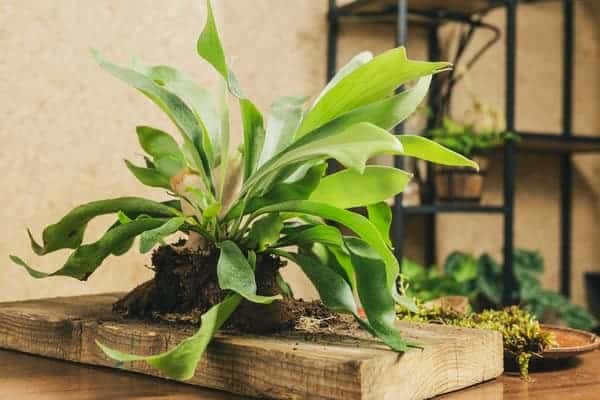 Image source: justhouseplants
Image source: justhouseplants
Staghorn Fern is a stunning epiphytic fern that offers exotic green fronds resembling the horns of an elk or male deer. It is easy to grow from propagating its side shoots or spores. It grows well in bright, indirect light, well-watered in a warm, and well-draining starter mix.
#14 Button Fern (Pellaea rotundifolia)
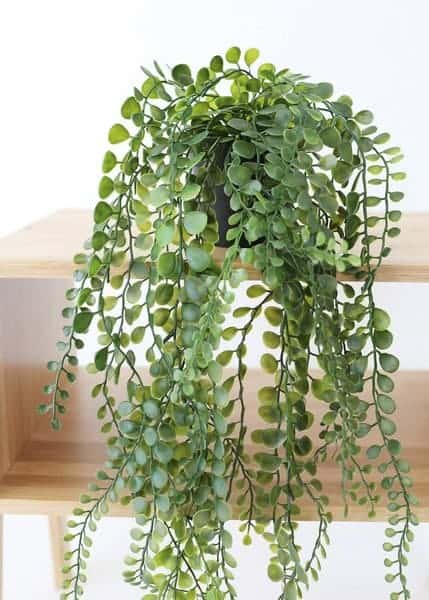 Image source: ifloralart
Image source: ifloralart
Native to New Zealand, the Button Fern is a beautiful and easy-to-grow plant. It produces round and small leaflets or ‘buttons’ on slim stems, hence the name.
#15 Christmas Fern (Polystichum acrostichoides)
 Image source: bigplantnursery
Image source: bigplantnursery
The fern variety offers glossy and green fronds that give the best color around Christmas time, so its name comes from this. Grow it in bright and indirect light for the best color. Also, water the plant once a week and keep the soil consistently moist.
GARDEN
15 Best Houseplants for Your Bathroom

The bathroom is always the most cleaned in the house but it is missed in decoration. Most people also think that the area of the bathroom is small that can’t set any kind of decoration or apply sophisticated architecture. However, adding a green touch by growing some of the best bathroom plants below will give your bathroom a fresh look!
1. Cast Iron Plant
 Image source: plantvine
Image source: plantvine
This incredibly tough houseplant, which appears to thrive on neglect, certainly lives up to its name. The cast iron plant can survive low light, infrequent watering, and extreme heat.
Nevertheless, for best results place this potted plant in low to moderate light – keeping out of direct sunlight, and water it regularly, allowing it to dry out before re-watering.
The cast iron will happily thrive in temperatures from 50 to 85 degrees.
2. Dracaena
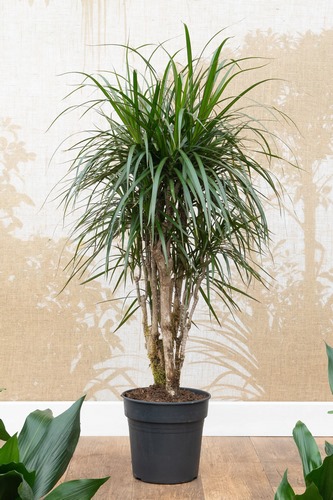 Image source: houseofplants
Image source: houseofplants
Dracaena plants, or dragon plants, are fantastic air purifiers which come in over 40 varieties.
This undemanding plant prefers light shade as its leaves will scorch if too bright; and a level of humidity not generally found in most rooms. Therefore, by placing your dragon plant in the bathroom, the lighting and humidity will prevent brown leaf tip and keep its greenery bright and flawless.
3. Orchid
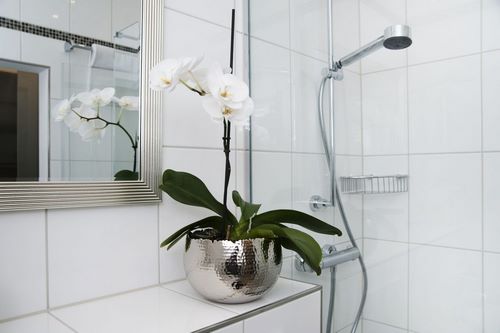 Image source: realsimple
Image source: realsimple
Give your bathroom a luxury spa feel with the addition of a subtle yet elegant orchid plant.
Place your orchid on the bathroom windowsill, where the indirect sunlight will provide adequate light but won’t cause leaf scorch; while the high humidity mirrors the flower’s natural environment.
It’s also a relatively compact flower making it perfect for smaller rooms, where it can be perched on the corner of the bathtub or next to the sink.
4. Pothos
 Image source: bobvila
Image source: bobvila
The golden pothos boasts beautiful marbled, heart-shaped leaves and is yet another low maintenance plant for your bathroom.
Ideal greenhouse conditions for this plant are very bright indirect light, high humidity, and warm temperatures.
However, as the bathroom ticks two out of three of these conditions, your pothos should do just fine indoors, although its leaves many not grow to the gigantic size they would with more light!
In order to stop the pothos getting out of control, and to save on space, hang it from the ceiling or high shelf.
5. Aloe Vera
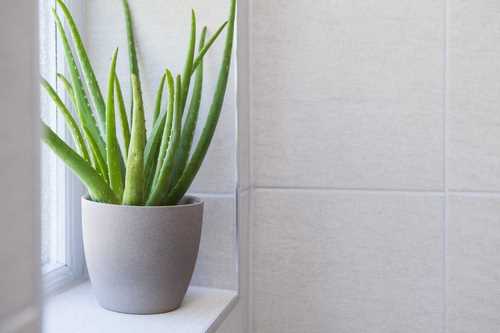 Image source: gardentabs
Image source: gardentabs
The aloe plant just keeps on giving! Not only is it known as the ‘plant of immortality’ because it is so difficult to kill, it is an incredibly useful plant to have around the home.
Aloe vera juice is bursting with vitamins and minerals, while the gel can be used as a topical treatment for minor cuts and burns, insect bites, dry skin and more.
This striking and healing plant should be placed close to the bathroom window and, because of its low water requirements, the humidity alone may meet most of its water needs!
6. Peace Lily
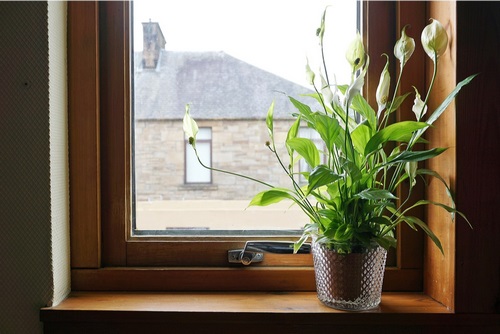 Image source: bustlingnest
Image source: bustlingnest
The peace lily is a striking flower, with glossy leaves and white blooms. It thrives in low light conditions, although it should be exposed to some indirect sunlight.
To simulate the natural humidity of the tropics, a daily misting or position next to a steamy shower is a must for the peace lily.
It’s another of NASA’s best plants for air purity, as it helps to filter out harmful benzene, trichloroethylene, and formaldehyde toxins.
7. Chinese Evergreen
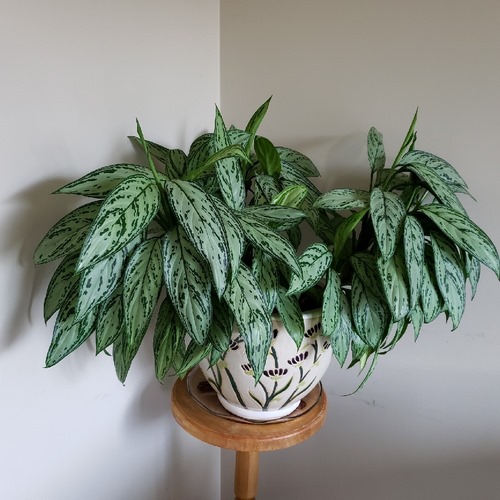 Image source: gardentags
Image source: gardentags
Boasting green leaves streaked with white or yellow, the tropical Chinese evergreen is one of the most durable plants you can grow, and has even been described as ‘almost foolproof’!
These plants thrive in medium to low light, or indirect sunlight. Although the Chinese evergreen prefers the warm temperatures and humid conditions of the bathroom, it’s flexible enough to tolerate other environments if necessary.
8. Philodendron
 Image source: sunrisespecialty
Image source: sunrisespecialty
This tropical indoor plant requires little in the way of care.
Philodendrons prefer the medium light intensity they would have on the jungle floor. If the light is too intense, its leaves will turn yellow; but if the leaves are widely spaced, it may need more light so you should consider installing fluorescent bulbs.
Although this hardy plant can tolerate average humidity, high levels promote lush, shiny foliage. Ideal growing temperatures are between 75 and 85 degrees F.
9. Bamboo
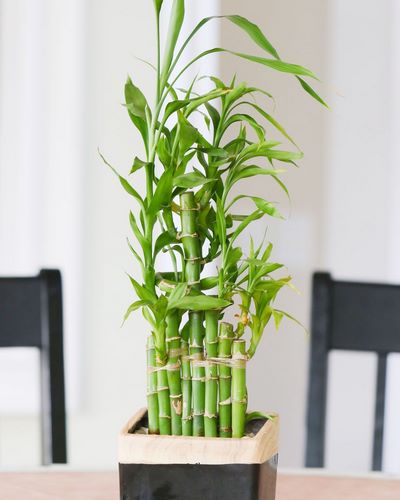 Image source: housebeautiful
Image source: housebeautiful
Lucky bamboo needs very little light to grow, and should be placed in low, indirect light.
It doesn’t even need any soil – simply pop the stalk into a container filled with pebbles and water. Change the water every two to four weeks.
Be warned that this is a fast growing plant, but you can curtail its growth by providing a physical barrier (such as a recessed shelf) or by shaping it regularly.
10. Snake Plant
 Image source: instagram
Image source: instagram
Also known as Mother-in-Law’s Tongue, the leaves of the snake plant grow upright, and feature yellow or white edging.
One of the hardiest houseplants, the snake plant can survive low light levels and is flexible in terms of heat and water.
The snake plant also filters some nasty household toxins from the bathroom air – including formaldehyde which can be found in cleaning products, tile grout, adhesives, and even some cosmetics!
11. ZZ Plant
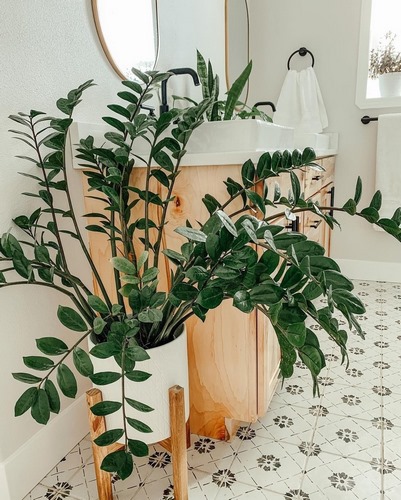 Image source: stylecurator
Image source: stylecurator
Dubbed the ‘eternity plant’ because it can tolerate quite a bit of neglect, the ZZ boasts beautiful oval-shaped, glossy leaves that will bring a fresh and vibrant feeling to any bathroom.
Although deep shade or direct sunlight don’t work for this plant, it can grow in most other light conditions such as a north, east or west facing window; and in a wide humidity range.
12. Spider Plant
 Image source: homedit
Image source: homedit
Commonly found in public spaces, the spider plant helps remove odors, fumes and around 90% of formaldehyde from the air.
This plant can grow in a wide range of conditions and requires little in the way of care. Because of this, they work well in bathrooms where they get either full sun or shade, although if plantlets fail to develop the plant is probably not getting enough light.
Allow the top layer of the soil to dry out between waterings.
13. Begonia
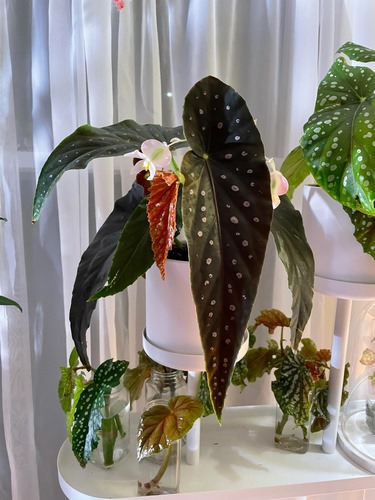 Image source: reddit
Image source: reddit
These pretty blooms do well indoors.
In fact, in many climates, they must be overwintered inside – with the bathroom being one of the best locations to do just this.
Begonias do best in fluorescent lighting, although they can survive when placed in window locations too (the exception being north-facing windows). They also require daily bathroom humidity or regular misting.
14. Ivy
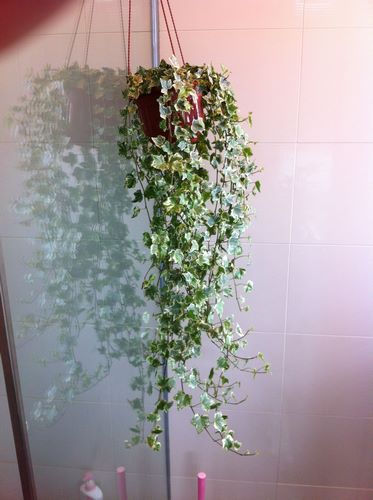 Image source: pinterest
Image source: pinterest
Ivy, particularly English Ivy, is one of NASA’s top air purifying plants. It can even help you keep the bathroom clean and hygienic by removing feces and mold from the surrounding air!
In bathrooms where space is at a premium, the ivy plant can be placed on a ledge or in a hanging basket where the leaves can elegantly trail down.
Needing just moderate exposure to sunlight, this evergreen vine enjoys the high humidity levels commonly found in bathrooms.
15. Boston Fern
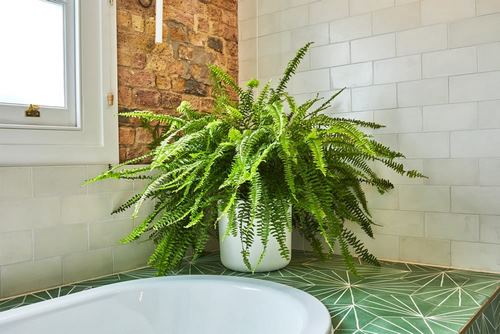 Image source: patchplants
Image source: patchplants
A popular variety of fern with frilly leaves and long, hanging fronds, the Boston fern is native to sub-tropical and tropical rain forests.
It grows best when placed on a windowsill or in a position which receives lots of indirect light. Humidity and temperatures of between 55 and 75 degrees are also important for your fern to thrive. In the growing months, the soil should be kept moist, but not saturated.
Other ferns also do well in bathrooms, including the Asparagus, Staghorn, and Bird’s Nest varieties.
-

 GARDEN12 tháng ago
GARDEN12 tháng ago4 Easiest Ways to Get Free Plants
-
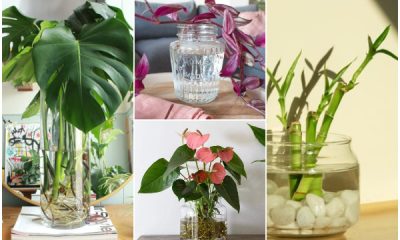
 GARDEN9 tháng ago
GARDEN9 tháng ago15 Houseplants That Grow Well in Vases with Water
-

 FUNNY12 tháng ago
FUNNY12 tháng ago30 Funny and Perplexing Photos That Make You Laugh All Day
-

 FUNNY12 tháng ago
FUNNY12 tháng ago30 Weirdest Things That People Came Across On The Subway
-

 ANIMALS12 tháng ago
ANIMALS12 tháng agoBritish Angler Caught Huge 67-Pound Goldfish in the World
-
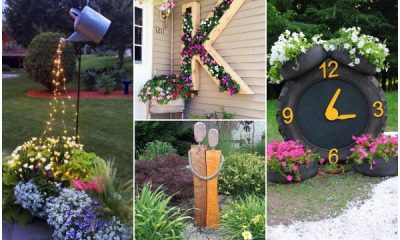
 DIY & CRAFT11 tháng ago
DIY & CRAFT11 tháng ago19 Easy and Creative DIY Ideas to Enhance Front Yard
-

 FUNNY12 tháng ago
FUNNY12 tháng ago22 Design Fails That Will Make You Laugh Out Loud
-

 GARDEN10 tháng ago
GARDEN10 tháng ago30 Shimmering Side Yard Landscape Ideas



